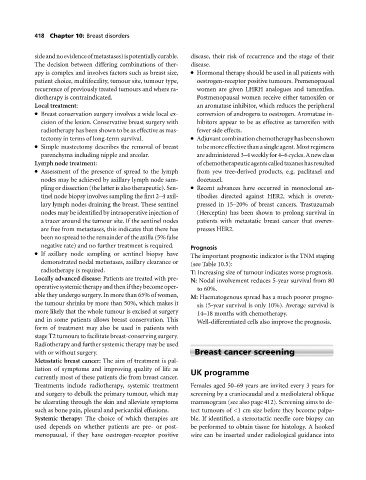Page 422 - Medicine and Surgery
P. 422
P1: KTX
BLUK007-10 BLUK007-Kendall May 12, 2005 20:3 Char Count= 0
418 Chapter 10: Breast disorders
sideandnoevidenceofmetastases)ispotentiallycurable. disease, their risk of recurrence and the stage of their
The decision between differing combinations of ther- disease.
apy is complex and involves factors such as breast size, Hormonal therapy should be used in all patients with
patient choice, multifocality, tumour site, tumour type, oestrogen-receptor positive tumours. Premenopausal
recurrence of previously treated tumours and where ra- women are given LHRH analogues and tamoxifen.
diotherapy is contraindicated. Postmenopausal women receive either tamoxifen or
Local treatment: an aromatase inhibitor, which reduces the peripheral
Breast conservation surgery involves a wide local ex- conversion of androgens to oestrogen. Aromatase in-
cision of the lesion. Conservative breast surgery with hibitors appear to be as effective as tamoxifen with
radiotherapy has been shown to be as effective as mas- fewer side effects.
tectomy in terms of long-term survival. Adjuvantcombinationchemotherapyhasbeenshown
Simple mastectomy describes the removal of breast tobemoreeffectivethanasingleagent.Mostregimens
parenchyma including nipple and areolar. areadministered3–4weeklyfor4–6cycles.Anewclass
Lymph node treatment: ofchemotherapeuticagentscalledtaxaneshasresulted
Assessment of the presence of spread to the lymph from yew tree-derived products, e.g. paclitaxel and
nodes may be achieved by axillary lymph node sam- docetaxel.
pling or dissection (the latter is also therapeutic). Sen- Recent advances have occurred in monoclonal an-
tinel node biopsy involves sampling the first 2–4 axil- tibodies directed against HER2, which is overex-
lary lymph nodes draining the breast. These sentinel pressed in 15–20% of breast cancers. Trastuzumab
nodes may be identified by intraoperative injection of (Herceptin) has been shown to prolong survival in
atraceraround the tumour site. If the sentinel nodes patients with metastatic breast cancer that overex-
are free from metastases, this indicates that there has presses HER2.
been no spread to the remainder of the axilla (5% false
negative rate) and no further treatment is required. Prognosis
If axillary node sampling or sentinel biopsy have The important prognostic indicator is the TNM staging
demonstrated nodal metastases, axillary clearance or (see Table 10.5):
radiotherapy is required. T: Increasing size of tumour indicates worse prognosis.
Locally advanced disease: Patients are treated with pre- N: Nodal involvement reduces 5-year survival from 80
operativesystemictherapyandtheniftheybecomeoper- to 60%.
able they undergo surgery. In more than 65% of women, M: Haematogenous spread has a much poorer progno-
the tumour shrinks by more than 50%, which makes it sis (5-year survival is only 10%). Average survival is
more likely that the whole tumour is excised at surgery 14–18 months with chemotherapy.
and in some patients allows breast conservation. This Well-differentiated cells also improve the prognosis.
form of treatment may also be used in patients with
stage T2 tumours to facilitate breast-conserving surgery.
Radiotherapy and further systemic therapy may be used
with or without surgery. Breast cancer screening
Metastatic breast cancer: The aim of treatment is pal-
liation of symptoms and improving quality of life as UK programme
currently most of these patients die from breast cancer.
Treatments include radiotherapy, systemic treatment Females aged 50–69 years are invited every 3 years for
and surgery to debulk the primary tumour, which may screening by a craniocaudal and a mediolateral oblique
be ulcerating through the skin and alleviate symptoms mammogram (see also page 412). Screening aims to de-
such as bone pain, pleural and pericardial effusions. tect tumours of <1 cm size before they become palpa-
Systemic therapy: The choice of which therapies are ble. If identified, a stereotactic needle core biopsy can
used depends on whether patients are pre- or post- be performed to obtain tissue for histology. A hooked
menopausal, if they have oestrogen-receptor positive wire can be inserted under radiological guidance into

